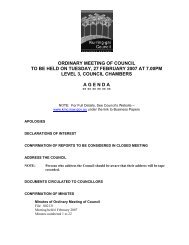Ku-ring-gai Heritage Conservation Areas North Inventory Sheet
Ku-ring-gai Heritage Conservation Areas North Inventory Sheet
Ku-ring-gai Heritage Conservation Areas North Inventory Sheet
You also want an ePaper? Increase the reach of your titles
YUMPU automatically turns print PDFs into web optimized ePapers that Google loves.
<strong>Ku</strong>-<strong>ring</strong>-<strong>gai</strong><br />
<strong>Heritage</strong> <strong>Conservation</strong> <strong>Areas</strong> <strong>North</strong> <strong>Inventory</strong> <strong>Sheet</strong><br />
Historical<br />
Significance<br />
The area has strong historical association with the Wahroonga Progress Association, responsible for<br />
formal street tree avenues, layout of Wahroonga Park, and the system of through-block pedestrian<br />
pathways, and with prominent architects including Howard Joseland who designed 11 houses in the<br />
area, and Sir John Sulman, who designed the heritage-listed shops facing Wahroonga Park, and<br />
also has historical association with prominent early residents including John Thomas Toohey, one of<br />
the Gillespie brothers, and others.<br />
Historical Assoc<br />
Significance<br />
Aesthetic<br />
Significance<br />
Wahroonga <strong>Heritage</strong> <strong>Conservation</strong> Area is of heritage significance for its distinctive residential<br />
streetscapes which evidence the transformation of early subdivisions of the 1890s into the later<br />
rectilinear grid lot street and lot pattern of later subdivisions including the Wahroonga Heights<br />
Estate. The area contains a significant collection of grand residences from the Federation and<br />
Inter-war periods, built following the opening of the <strong>North</strong> Shore railway line in 1890, many of these<br />
the residences of prominent families of this period, and often designed by prominent architects, for<br />
example the 1894 Ewan House (formerly Innisfail) designed by architect Herbert Wardell for John<br />
Thomas Toohey, and eleven houses designed by the architect Howard Joseland. The western end<br />
of Burns Road and western side of Coonanbarra Road are representative streetscapes of intact<br />
more modest Federation period houses.<br />
The through-block pathways and formal avenues of street trees within the area (in Burns Road,<br />
Water Street and Coonanbarra Road) along with the formal landscaping of Wahroonga Park, and<br />
its distinctive John Sulman-designed shops in Coonanbarra Road facing the Park, are a tribute to<br />
the work of the Wahroonga Progress Association in the early 20th century (which included Sulman<br />
as a member), and have resulted in a high-quality and distinctive residential landscape.<br />
Social Significance<br />
KU-RING-GAI HERITAGE CONSERVATION AREAS NORTH INVENTORY

















